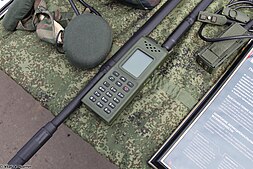R-187 Azart
| R-187-P1 "Azart" | |
|---|---|
 | |
| Type | Handheld tactical radio |
| Service History | |
| In service | since 2014 |
| Used by | Russian Armed Forces,
Russian public safety agencies |
| Wars | Syrian Civil War, Russo-Ukrainian War |
| Production history | |
| Manufacturer | NPO Angstrem |
| Production years | 2014 - ongoing |
| Specifications | |
| Frequency range | 27-520 MHz |
| Transmit power | up to 4 watts |
| Modes | analog voice, digital voice and data |
| Weight | 466 g (w/o battery and antenna) |
The R-187 "Azart" (Russian: Р-187 "Азарт", "Excitement") is a Russian tactical and public safety handheld radio developed and produced by NPO Angstrem[1] for the Russian Ministry of Defense. It is a component of the Ratnik infantry combat system.[2]
Service[edit]
The Azart-P1 was first seen in use by Russian public safety agencies during the 2014 Winter Olympics in Sochi, Russia.[3] The Azart-P1 has seen service with the Russian Armed Forces during its involvement in the Syrian Civil War[4] and the War in Ukraine. Many Azart radios have been captured Ukrainian soldiers.[5]
The model in service with the Russian Armed Forces is the R-187-P1, the export model is the R-187-P1E.[1] The R-187V is a vehicle mounted version of the R-187-P1 with a higher transmit power and larger frequency range.[6]
Technical characteristics[edit]
The Azart-P1 is capable of VHF/UHF Line of Sight (VULOS) communications in simplex modes, duplex, and repeater modes. It is also compatible with TETRA networks[7] in trunked and conventional modes, and GSM 900/1800 cellular networks.
The radio is supplied with a 27-520 MHz long antenna to cover the radios entire frequency range, a medium 100-520 MHz antenna, and a short 136-520 MHz antenna.[1] Ukrainian radio experts report these antennas typically achieve a standing wave ratio of 1.5 to 3.[5]
It has been revealed that some Azart-P1 radios were manufactured in China as a result of an embezzlement scheme that began in 2013 by General Khalil Arslanov, then head of Main Directorate of Communications of the Armed Forces of Russia.[8] Some radios have also been found to use Taiwanese-made, American-designed microchips for encrypting radio traffic.[9]
Specifications[edit]
- Frequency range: 27 - 520 MHz[1]
- Modes: analog (AM, FM, USB, LSB) and digital (GSM, TETRA)
- Data speed: up to 256 kbit/s, typically 7.2 kbit/s
- Frequency hoprate: >20,000 hops/second ("Azart" waveform), 100 hops/second ("Aqueduct" waveform)
- Transmit power: up to 4 watts
- Navigation: GPS, GLONASS
- Storage capacity: 512 MB
- Antenna connector: TNC female
- Interfaces: USB, RS-485, Bluetooth
- Battery life: up to 12 hours
- Weight: 466 grams (w/o battery and antenna)
Comparable radios[edit]
References[edit]
- ^ a b c d "Azart-P1". www.cryptomuseum.com. Retrieved 2024-02-01.
- ^ Ebbutt, Giles (19 April 2018). "DSA 2018: Azart showcases Ratnik combat radio | Jane's 360". Archived from the original on 21 April 2018.
- ^ ""Военные" радиостанции "Ангстрема" использовались для связи в Сочи". Время электроники (in Russian). 2014-03-23. Retrieved 2024-01-31.
- ^ Thomas, Timothy (June 2020). Russian lessons learned in Syria - An assessment (PDF). MITRE Center for Technology and National Security. p. 18.
- ^ a b "Як користуватися трофейною радіостанцією Р-187-П1 "Азарт"". armyinform.com.ua (in Ukrainian). Retrieved 2024-02-01.
- ^ "Azart - Standardized Tactical Command and Control Radio-Communication System". Federal Service for Military-Technical Cooperation. Retrieved 2024-02-01.
- ^ Withington, Dr Thomas (2022-04-01). "TETRA Talk". Armada International. Retrieved 2024-02-01.
- ^ "К военным поставкам подходят с гражданским азартом". Коммерсантъ (in Russian). 2021-03-04. Retrieved 2024-02-01.
- ^ "Russian "native" military radio station uses microchip made in Taiwan to encrypt data - Technology Org". 2022-11-20. Retrieved 2024-02-01.
